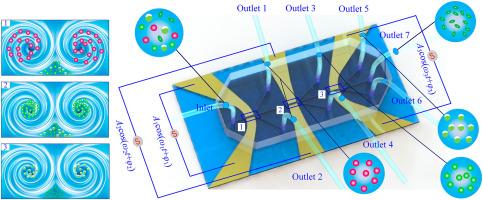Microfluidic fractionation of microplastics, bacteria and microalgae with induced-charge electro-osmotic eddies
IF 5.7
2区 化学
Q1 CHEMISTRY, ANALYTICAL
引用次数: 0
Abstract
Background
Fractionation of microalgal cells has important applications in producing pharmaceuticals and treating diseases. Multiple types of microalgal cells generally coexist in the oceans or lakes and are easily contaminated by microplastics and bacteria. Therefore, it is of paramount significance to develop an effective fractionation approach for microalgal cells for biological applications. Counter-rotating induced-charge electro-osmotic (ICEO) eddies present unique advantages in separating microalgal cells for flexible electrode extension fashion and profile regulation manner. Enthused by these, we proposed a contact-free microfluidic approach for the fractionation of microplastics, bacteria, and microalgae with extensible counter-rotating ICEO eddies.
Results
Firstly, we investigated the flow-field distribution actuated by counter-rotating ICEO eddies, the influence of working parameters on the fluid velocity, and the effect of particle sizes and charges on particle separation. Secondly, depending on the investigation of the movement of microparticles and microalgal cells, we explored synthetic effects of flow rate, voltage, and frequency on the fractionation of microalgal cells from microplastics with an efficiency of about 100 %. Thirdly, this method was used to remove the bacteria for pure Dunaliella salina with a purity of about 95.24 %. Fourthly, this approach was engineered in the fractionation of Diatoms, Chlorella, and Dunaliella salina, and the influence of voltage and frequency on the purity of microalgae was studied. Finally, we proposed a multi-stage separation of microalgal cells with extended counter-rotating ICEO eddies and obtained an efficiency of 91.00 % in the first stage and a purity of 91.55 % and 90.48 % in the second stage.
Significance
This contact-free method holds good potential in the selection of target microalgal cells to address the tricky issues of chronic wound treatment with the advantage of flexible electrode extension fashion and profile regulation manner.


微塑料、细菌和微藻的诱导电荷电渗透涡流微流控分馏
微藻细胞的分离在药物生产和疾病治疗中有着重要的应用。多种类型的微藻细胞通常在海洋或湖泊中共存,容易被微塑料和细菌污染。因此,开发一种有效的微藻细胞分离方法具有重要的生物学意义。反向旋转感应电荷电渗透(ICEO)涡流在微藻细胞分离中具有独特的优势,具有柔性电极延伸方式和轮廓调节方式。受此启发,我们提出了一种无接触的微流体方法,用于微塑料、细菌和微藻的分离,该方法具有可扩展的反向旋转ICEO涡流。结果首先研究了逆旋转ICEO涡流驱动下的流场分布、工作参数对流体速度的影响以及粒径和电荷对颗粒分离的影响。其次,通过对微颗粒和微藻细胞运动的研究,我们探索了流速、电压和频率对微藻细胞从微塑料中分离的综合影响,分离效率约为100%。第三,采用该方法对盐渍杜氏藻进行了纯化,纯度约为95.24%。第四,将该方法应用于硅藻、小球藻和盐藻的分选,研究了电压和频率对微藻纯度的影响。最后,我们提出了扩展逆旋转ICEO涡流对微藻细胞进行多级分离的方法,第一级分离效率为91.00%,第二级分离纯度分别为91.55%和90.48%。意义这种无接触方法具有柔性电极延伸方式和轮廓调节方式的优势,在选择靶微藻细胞解决慢性伤口治疗难题方面具有良好的潜力。
本文章由计算机程序翻译,如有差异,请以英文原文为准。
求助全文
约1分钟内获得全文
求助全文
来源期刊

Analytica Chimica Acta
化学-分析化学
CiteScore
10.40
自引率
6.50%
发文量
1081
审稿时长
38 days
期刊介绍:
Analytica Chimica Acta has an open access mirror journal Analytica Chimica Acta: X, sharing the same aims and scope, editorial team, submission system and rigorous peer review.
Analytica Chimica Acta provides a forum for the rapid publication of original research, and critical, comprehensive reviews dealing with all aspects of fundamental and applied modern analytical chemistry. The journal welcomes the submission of research papers which report studies concerning the development of new and significant analytical methodologies. In determining the suitability of submitted articles for publication, particular scrutiny will be placed on the degree of novelty and impact of the research and the extent to which it adds to the existing body of knowledge in analytical chemistry.
 求助内容:
求助内容: 应助结果提醒方式:
应助结果提醒方式:


